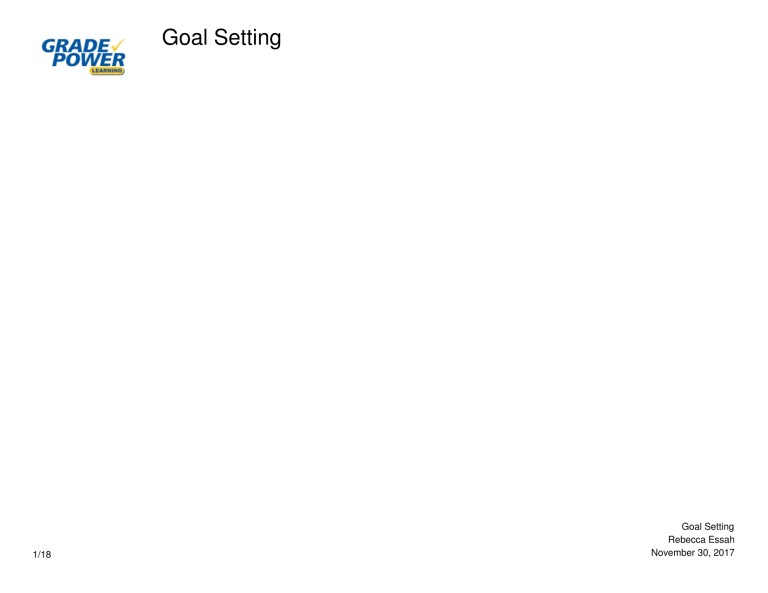
Goal Setting 1/18 Goal Setting Rebecca Essah November 30, 2017 Goal Setting & Oxford Learning... Two Peas in a Pod! Goal Setting and Oxford Learning go hand in hand. Why? Because at Oxford Learning, we want all our students to reach their highest potential, and goal setting is one very important step to helping them get there! 2/18 Goal Setting Rebecca Essah November 30, 2017 Why set goals? Because if you aim at nothing, you'll hit it every time! There are a number of benefits to goal setting, especially in our centres. Setting goals helps students manage their time, keep on task, and increase their self-esteem and motivation. It gives them something to aim for, a reason to try harder, and allows them to earn more control over their own lives! 3/18 Goal Setting Rebecca Essah November 30, 2017 How do we set effective goals? Students are more motivated to work towards goals that they have set themselves. Before coming to Oxford Learning, many students have never been taught to set effective goals. So, the first thing we need to do is teach them how! The best way to do this is to encourage students to set CAM goals—clear, achievable, and measurable. That way, every goal they set is attainable, motivating, and will make them want to keep setting goals! 4/18 Goal Setting Rebecca Essah November 30, 2017 Setting CAM Goals Every goal students set has to be CAM—clear, achievable, and measurable. Otherwise, students may set goals that are untrackable, unattainable, and unrealistic, all of which leads to disappointment, a decrease in self-esteem, and a loss of motivation. Clear: Unless you can say it clearly and succinctly, you will not be able to aim for it. Achievable: Goals need to be realistic and attainable. It's important to consider any limitations (e.g. time) then determining whether a goal is achievable. Measurable: You need to know both how you are progressing, and when you have actually reached your goal. Let's look at some goals and see if are all CAM. 5/18 Goal Setting Rebecca Essah November 30, 2017 Setting CAM Goals: Giovanni Math is a weak subject for Giovanni. He currently has a 57%. The exam is in one month, and he sets the following goal: "I want my final mark in the course to be 95%." Is his goal clear? Achievable? Measurable? It is definitely clear, and indeed measurable. But, we know, for Giovanni, it likely isn't achievable, given the time constraint. We're happy that Giovanni wants to do well in the course, but we also know that he'll end the course disappointed with his final grade. We need to help him set a more achievable goal, one that is accomplishable in one month. 6/18 Goal Setting Rebecca Essah November 30, 2017 Setting CAM Goals: Paula Paula plays forward on her hockey team. She is a good player, but knows that she can still improve. She sets this goal: "I want to become the best player on my team." Is her goal clear? Achievable? Measurable? It's safe to say that she can definitely become a better player, so her goal is achievable; however, what does "best" mean? The fastest? Score the most goals? Become team captain? It's far too ambiguous to be considered clear, and therefore would be hard to measure—at what point would she feel she has reached her goal? 7/18 Goal Setting Rebecca Essah November 30, 2017 Setting CAM Goals: Denise Denise has always struggled to take good notes. She isn't sure what the most important parts are, so she tends to write down everything the teacher says, which means a lot of unnecessary reading come study time. She wants to improve that, so she sets the following goal: "I want to take better notes so studying is easier." Is her goal clear? Achievable? Measurable? While it is clear, and achievable, the question is: how will she measure that achievement? How does she plan on improving her note taking skills? How will she measure how effective her new skills are? These questions are difficult to answer without a more measurable goal. 8/18 Goal Setting Rebecca Essah November 30, 2017 Setting CAM Goals As you can see, non-CAM goals are bound to lead to disappointment and a loss of motivation in our students. CAM goals, on the other hand, do the opposite! They make students want to set more goals, because they understand how goals can motivate and encourage them to reach their highest potential. 9/18 Goal Setting Rebecca Essah November 30, 2017 Setting CAM Goals with Your Students It's important that students set their own goals, instead of the teacher setting them for the students. This way, students are accountable for reaching those goals. Let's look at some ways you can use goal setting in an Oxford Learning Centre. 10/18 Goal Setting Rebecca Essah November 30, 2017 Goal Setting: General Tips In addition to ensuring that all goals are CAM, there are a couple of other tips to keep in mind: Allow the student to set the goal his or herself; however, you may need to help the student set a goal that is reasonable— sometimes our students aren't very realistic when learning to set goals! Have the student verbalize the goal, in his or her own words, to ensure he or she understands it. Depending on the length of the goal (one class, one week, one month, six weeks, etc.) check in with the student regularly to discuss progress: How far along are you? Based on where you are now, will you reach your goal in time? Does the goal need to be modified? What might hinder you from reaching your goal? Checking in will help the student stay motivated and be able to adjust if the goal if need be. If the student doesn't reach the goal, it is not a wasted failure! Instead, take time to reflect and verbalize on why the goal wasn't reached, and what could be done differently next time in order to ensure the goal is reached. 11/18 Goal Setting Rebecca Essah November 30, 2017 Setting Time Management Goals If a student is not managing his or her time effectively, ask him or her: "Let's set a goal to help you stay focused and help you manage your time. How long do you need to finish this booklet?" Work with the student to ensure that the amount of time is reasonable, given the activity. Then, have him or her verbalize the goal, for example: "I will finish my Short and Long Vowels booklet in six minutes." Keep an eye on the clock. Ensure you let him or her know how much time is left as time goes on. When the time is up, celebrate! If the student didn't finish the work in time, discuss how setting the goal still helped the student to manage his or her time effectively. Also discuss what stopped the student from finishing the work in time, so that next time, the goal can be reached. 12/18 Goal Setting Rebecca Essah November 30, 2017 Setting Focus Goals Students who struggle to focus or pay attention can also benefit from goal setting. By setting goals like "I want to finish four booklets tonight" or "I want to work for 10 minutes without becoming distracted" students can improve their focus while also completing their work. Also, students can set a long-term goals, for example: "I want to get all of my booklets done in one class" and then break that goal into smaller, more manageable goals, such as: "I want to get three booklets done each class this week, and four next week." When students see themselves accomplishing goal after goal, their self-esteem improves, which motivates them to keep improving! 13/18 Goal Setting Rebecca Essah November 30, 2017 Setting Reading Goals The following are some examples of reading goals that teachers can set with students. Pausing after punctuation. Reflecting and verbalizing about each sentence before moving onto the next. This is especially helpful to students with low comprehension! Using phonics and decoding to sound out new or difficult words. Using a ruler to keep track of the line that the student is reading. This is helpful to students with tracking issues. Using inflection and intonation when reading. Checking the definitions of new words. 14/18 Goal Setting Rebecca Essah November 30, 2017 Setting Writing Goals The following are some examples of writing goals that teachers can set with students. Writing neatly and legibly Remembering capitals Remembering punctuation Writing longer sentences or paragraphs instead of the bare minimum Using the amount of space provided to write the answer (teaching them that the space provided is often a gauge for how much they are supposed to write) Editing sentences using the Editing Checklist before passing it to the teacher to correct 15/18 Goal Setting Rebecca Essah November 30, 2017 Setting Math Goals The following are some examples of math goals that teachers can set with students. Using the five steps properly, once they've been learned, instead of diving into a problem. Showing all steps/work instead of jumping to the answer (even if they understand) Verbalizing what the question is asking them before starting to write Reviewing previous concepts or lessons before beginning new concepts (to help comprehension) 16/18 Goal Setting Rebecca Essah November 30, 2017 Setting Study Skills Goals The following are some examples of study skills goals that teachers can set with students. Creating neat study notes Reading class notes every couple of days to ensure concepts are being understood, instead of waiting until test time. Dating every page Using the agenda every day to help manage time, homework, projects, assignments, etc. 17/18 Goal Setting Rebecca Essah November 30, 2017 Goal Setting: A Review Goal setting is part of helping our students reach their highest potential. All goals set should be CAM goals: Clear, Achievable, and Measurable. Students should set their own goals, with the help of their teacher, instead of having their teachers set goals for them. Goals can be set about almost anything! Reading, Writing, Math, Focus, Attitude, Organization, Task Persistence, Awareness—as long as the student can think about it, he or she can set a goal for it! It is important to check in with students to see how they are progressing in reaching their goals. Sometimes they will need a gentle reminder and some words of encouragement! 18/18 Goal Setting Rebecca Essah November 30, 2017



